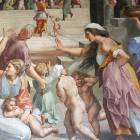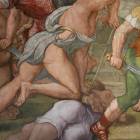Fire in Borgo, a painting by Raphael and Giulio Romano
What Medici family started in Florence, and was branded by their chronicler and propagandist Giorgio Vasari as the Renaissance, found its peak in Rome, with the help of Pope Julius II. Perhaps the name chosen by this pope, alluding to Julius Caesar, was not coincidental. The ambitions of this head of the Catholic Church ran far from the humility of a Christian preacher, and closer to the figure of an absolute monarch. Two centuries before the time of the French monarch Ludovic XIV, Julius II was the Catholic version of the Sun King.
Julius II started the most ambitious projects in the history of the Vatican, including Saint Peter’s Cathedral, the Sistine Chapel and the Vatican Rooms. For these and many others he employed among others the architect Donato Bramante, and painters Michelangelo, Leonardo Da Vinci and Raphael Sanzio.
Raphael painted the sumptuous rooms in the Belvedere Palace, each known today by the main fresco found in each, such as the famous School of Athens. Due to the scale of the projects started by Julius II, many were not finished before his death, as was the case with the frescoes in the room hosting the Fire in the Borgo.
The project was carried on by the first pope elected from the influential Medici family, Leon X. This obviously inherited the genius of his father, Lorenzo the Magnificent of using brilliant artists and their works to project power and gain influence and admiration. In this room there are four large frescoes presenting legendary deeds of other previous popes named Leo, such as the coronation of Charlemagne. The kings are painted with a different technique, in monochrome shades, below the frescoes, while for all the popes the figure of Leon X was used. Fire in the Borgo goes a step forward, attributing to pope Leon IV even miraculous powers.
Inspired by a Vatican chronicle, this painting presents the scenes of terror during a fire that erupted in Borgo, a neighborhood of Rome, which the popular legend claims was stopped by the Pope with a single gesture. As the amount of work in all the rooms in the Vatican was overwhelming, Raphael heavily relied on his students. For this fresco in particular it is presumed that he made the general drawings and decided the framing. But the actual details of the painting were carried out by his talented student Giulio Romano and other unknown craftsmen. The artistic excellency of Raphael’s team is especially obvious in the reproduction of human anatomy in movement and of emotional reactions.
- Home Page
start page - Architecture
landmark buildings - Sacred architecture
places of worship - Nature
landscape photography - Concert
performing artists - Christmas
Santa Claus pictures
- Jooble
jobs for photographers - Escape
an out of control blog - Merry Christmas
The best organizer of Christmas parties - Astro photo
Eclipse hunting and astrological photography








